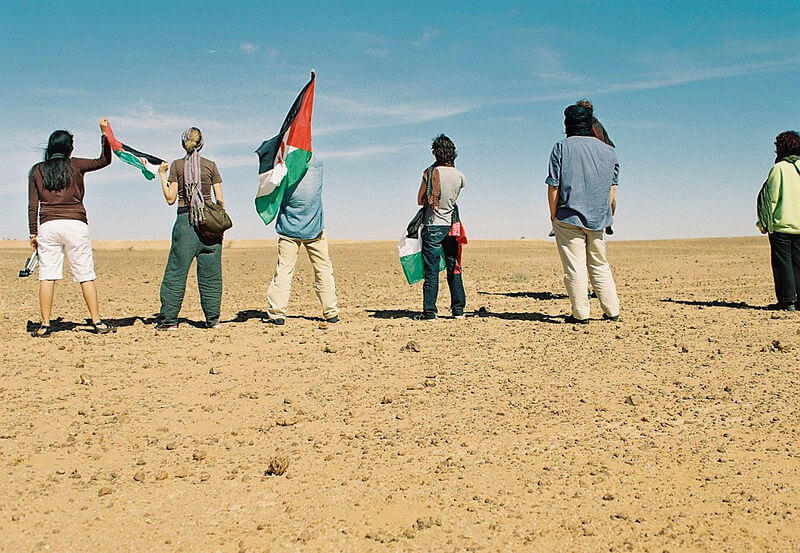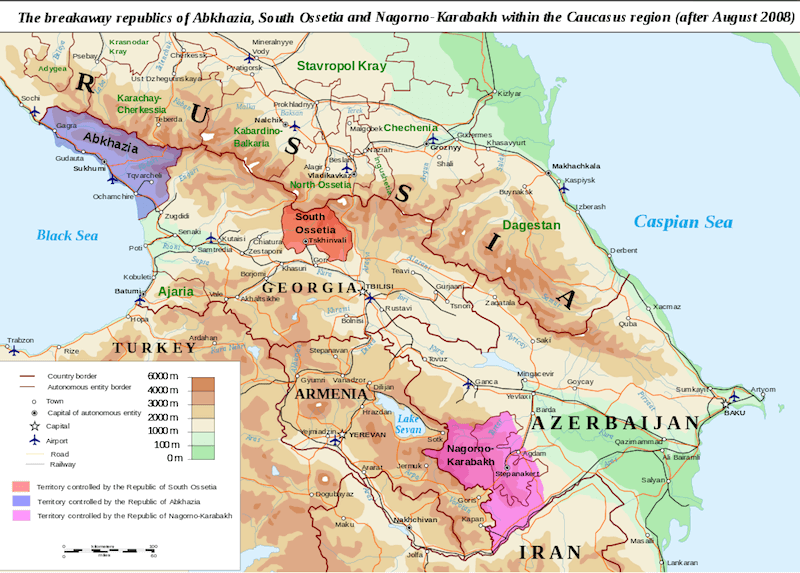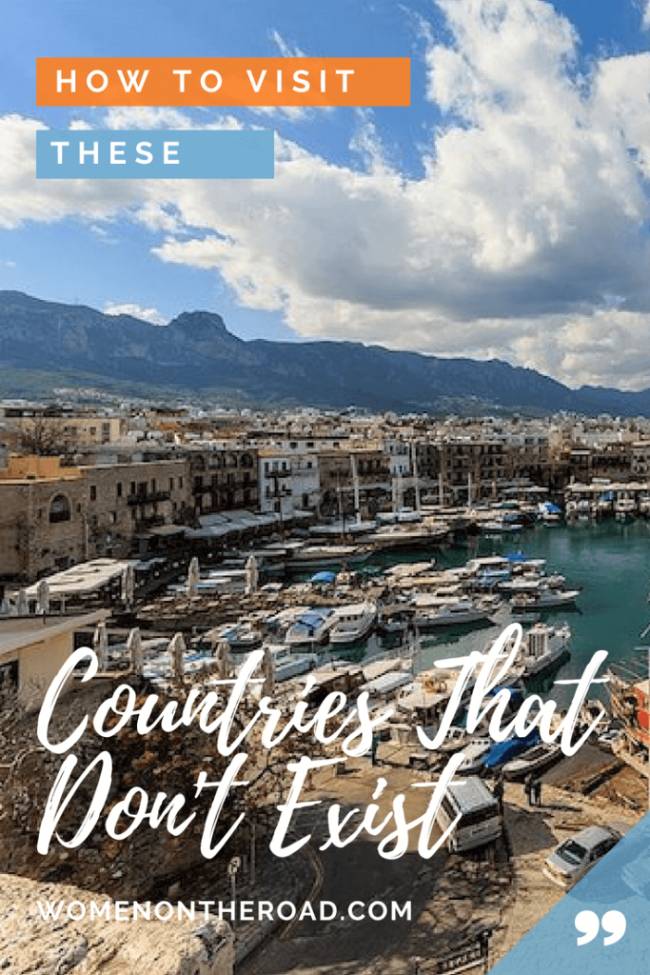Imagine going into a train station and asking for a ticket to a certain destination, only to be told: “There is no such place.”
It happens.
The world has a number of unrecognized countries - countries few others recognize as such, or which don’t legally exist, or that are countries inside countries.
And I’ve just come back from one of them.
HOW I VISITED TRANSNISTRIA
This small self-declared country along the Dniester River is squeezed between Moldova and Ukraine. It broke away from Moldova (which itself was once part of Romania) in 1990 and has since struck out on its own, recognized by itself and by Abkhazia, the Republic of Artsakh and South Ossetia, unrecognized nations themselves.
Russia’s 14th army lives there, as do some 2000 Russian peacekeepers who ‘protect’ this slice of pro-Russian land.
When the USSR ruled the region, it was part of the Moldavian Soviet Socialist Republic but when the Soviet empire crumbled, violence erupted. It ended with a ceasefire and there is an uneasy peace – but no resolution to Transnistria’s status.
It’s a strange thing: it operates as an independent country with its own flag, government and licence plates and yes, you do cross a border to reach it from Moldova. I received an immigration form with all the trappings of a regular border – customs check, cinder blocks and border barriers.
They take it extremely seriously – but as far as the UN, Moldova and most of the world is concerned, Transnistria is still part of Moldova.
Transnistria is the place to go for Soviet nostalgia if you missed the Soviet Union the first time around or if you didn’t and regret the ‘good old days’.
Here, on the fringe, the Soviet Union is alive and well, along with gigantic monuments and red-starred uniforms. And despite its size - larger than Luxembourg but smaller than Palestine - there is plenty to do and see.

The easiest way to visit Transnistria is on a day trip from Chisinau, Moldova’s capital. Just hop on the bus, get to the border, fill out those papers, and enter. The Moldovans don’t seem to mind.
If you don’t feel like going it alone, Transnistria does have at least one tour agency that offers a wide variety of tours of the area (I took the Communist tour). From Chisinau, it’s an easy day trip (the drive took less than two hours each way.)
If you prefer to walk around without yourself, the capital Tiraspol is small enough to see in just a few hours. You can get there by train or bus.

If you love less trodden places, going to a “non-country” has even more appeal: they tend to be less visited, more difficult to reach, and often, not exactly at peace. It’s a bit of an adventure, and usually an eye-opening one.
SO WHAT EXACTLY IS AN UNRECOGNIZED COUNTRY?
These are countries that may have control over their own territory but aren’t recognized as countries by others - not by most, in any case. (Here’s a long list of unrecognized countries or those that are only partially recognized.)
They are often small, usually conflict-ridden or only recently peaceful, with borders few others even admit are there. Some are former territories or provinces, others are stand-alone quasi-states but they all have one thing in common: they don’t, in fact, exist - at least not legally.
Just because unrepresented states don’t legally exist doesn’t necessarily mean you can’t go there.
I’m captivated by these unrecognized nations: status-free today but maybe next week or next month, their newly-uniformed border guards will be stamping your passport with a perfectly legal entry visa.
Who knows - they might end up sitting at the United Nations!
Take Kosovo, which broke away from Serbia in 2008: it has been recognized by 117 countries, although it doesn’t yet sit at the UN and is still unrecognized by Serbia or Russia, among others. And there are many other examples of breakaways that are moving forward along their path.
At the same time, a number of countries have not managed to stage-manage their independence and remain alone, unsupported and claimed by one or several entities. Here are just a few of these.
WESTERN SAHARA AND THE SAHRAWI ARAB DEMOCRATIC REPUBLIC (SADR)

On a recent visit to Southern Morocco my guide was Mohammed, a young Sahrawi man from the town of Mhamid. Together we visited the spot where Polisario soldiers had once tried to invade his town – it was several decades ago but the memory is still vivid.
The friction around Western Sahara is palpable in this part of Morocco, which has overseen the area since 1975 when Spain handed it over. Not everyone is pleased: not the Polisario, who want independence; not Algeria, which backs the Polisario; and not the UN, which has failed to break Morocco’s hold on the country. It doesn’t help that phosphates and fish are abundant and oil may lie offshore.
Despite the disputes over who rules what, travel to Western Sahara is certainly possible, according to Mohammed, especially to the capital El Aaiún/Laayoune (depending on where you sit politically). There’s also Tarfaya, where Antoine de Saint-Exupéry, author of The Little Prince, was stationed. And then there’s the desert itself.
Islamic extremists have been seen in the area, and some foreign officials worry the 2015 attacks on Mali and subsequent French intervention there could lead to retaliation in the Western Sahara. As in Algeria, the desert can hide anyone and kidnapping is a real threat. That said, travelers do visit regularly without any trouble at all.
Still want to go? In theory, you don’t need officially a visa from Morocco, which considers this part of its territory. You can either fly in from Morocco proper or take a bus from Marrakech. Best, if you can afford it, is to bring a car and driver who can negotiate the dusty, rough-topped roads, and don’t wander off the road because the country is mined.
These days, tensions between Morocco and Algeria are on the upswing after the US government decided in 2020 to recognize Morocco’s sovereignty over the area. It’s too early to tell but this could move the area from “sensitive” to “tinderbox” status.

NAGORNO-KARABAKH
Nagorno-Karabakh is an enclave within Azerbaijan but governed by Artsakh, a self-proclaimed independent republic. Officially, the world sees it as part of Azerbaijan.
It was during the late 1980s and early 90s, when the Soviet Union was falling apart. Nagorno-Karabakh, on the border with Armenia, was part of Azerbaijan but its Armenian majority chose to leave Azerbaijan, a choice dismissed by the Azeris despite rulings and referendums. The result: a war, followed by an uneasy truce and a stalemate in a region most governments warn you not to visit.
Yet it does sound rather delightful: hiking across the country along the marked Janapar Trail, mountains, and plenty of monasteries which I imagine to be relatively untouched, not to mention the supposed relics of St George the dragon slayer. The few travelers who have visited and written about it see no reason any of us should stay away.

Entry formalities are relatively straightforward. It seems the only way to arrive is via Yerevan, the capital of Armenia, where the official representation of Nagorno-Karabakh is located – and where you get your visa. Just remember that the visa will get you into trouble in Azerbaijan, so if that country is on your travel plan, get your visa stamped on a separate piece of paper.
Like any conflict or post-conflict zone this is the one piece of advice I would both give and take myself: stay away from the border, in this case the border with Azerbaijan. Until things settle down, sniper attacks are possible, landmines do exist, and the possibility of encounters with unfriendly armed forces remains a reality.

REPUBLIC OF SOUTH OSSETIA
South Ossetia is one of three breakaway Caucasus republics, the other two being Nagorno-Karabakh and Abkhazia. The region declared independence from Georgia in 1990: Russia for, Georgia against, the result being war for nearly two decades.
Almost no countries in the world recognize South Ossetia - with the exception of Nauru, Nicaragua, Russia, Syria and Venezuela – and the non-UN recognized countries of Nagorno-Karabakh and Transnistria.
This is not the safest part of the world to visit and while I’d have no hesitation about a trip to Nagorno-Karabakh (see above) I’d think twice about South Ossetia, especially since Georgia passed a law making travel there illegal unless you’re involved in humanitarian or security work. Still, here’s a 2016 trip report to South Ossetia that puts it into perspective, as does the video below. The only legal way to enter is through Russia.
Georgia is so set against South Ossetia’s independence it tried to take it back, with fighting erupting as recently as 2008 (a ceasefire is in place now but…). And in 2019, a potential confrontation was broiling with Georgia over a checkpoint on a disputed boundary.
Unstable it may be but it does sound intriguing, and South Ossetia does have some cultural attractions. Several travel agencies, like this one, appear to organize tours there. I’m not quite convinced it’s time yet.
ABKHAZIA
Nearly a decade after South Ossetia tried to leave Georgia, it was Abkhazia’s turn.
Unlike South Ossetia, Abkhazia can be reached easily overland via its border with Russia – from Sochi, to be precise – or from Georgia. Given its status as a breakaway province, I’d be careful about crossing back and forth to Georgia; Georgians might not look too kindly on your visiting a country they don’t see as one.
Entry formalities appear relatively straightforward and a visa application can be downloaded from the Ministry of Foreign Affairs website.
There also seems to be quite a bit to see: abandoned, war-battered buildings; the Black Sea; Stalin’s former dascha; beautiful scenery and intriguing architecture; places of worship; and the scientific research center that trains monkeys sent into space – I’ll pass on that one.
Few countries recognize Abkhazia (it’s in the same situation as South Ossetia) and most of the world considers it part of Georgia, so the same constraints apply: don’t get into trouble because no one will be able to help you from the outside.

TURKISH REPUBLIC OF NORTHERN CYPRUS (TRNC)

Northern Cyprus is a de facto state in the northern third of the island of Cyprus and is recognized only by Turkey. It’s easy to get to – you can fly in to Ercan Airport or take a ferry from Turkey or Israel.
TRNC, for short, came into being when Greece tried to annex Cyprus in 1974. Turkey retaliated with an invasion and the island was partitioned between the Greek Cypriot and Turkish Cypriot populations.
The visa situation has been vastly simplified for citizens of many countries (including the EU, US, Canada, Australia and NZ) who can come directly, via Turkey or though the border from the south.
Find out more about what to do when you get there. It’s a bit out of the way, and according to visitors it’s not like the rest of Cyprus at all - more like a cross between Turkey and Greece on the Mediterranean. As the tourist board calls it, “the Mediterranean as it used to be.” Sounds rather nice.

SOMALILAND
Somaliland, on the other hand, sounds a lot less nice but not irretrievably nasty. When Somalia collapsed in 1991, Somaliland split and declared itself independent from the rest of the country. Like other unrecognized countries, it’s… unrecognized.
But you can visit. These days, depending on your nationality, you can even get a visa on arrival if you arrive by air. If you’re traveling overland, you’ll have to get your visa at a Somaliland Mission (in Addis Ababa or Djibouti, for example). Remember, this is NOT Somalia so don’t confuse the two.
If you’ve always wanted to visit the Horn of Africa, this might be your chance. Somaliland is a better bet than Somalia, and it has a nascent tourism industry. For travelers who actually visit, the experience seems enjoyable – and relatively safe.

BEFORE YOU VISIT AN UNRECOGNIZED COUNTRY, REMEMBER…
- Unrecognized states are just that: no embassies, no consulates, no diplomatic relations, no international law, no help if you get into trouble.
- Because these are often offshoots of other countries, medical facilities may be limited.
- Your travel insurance might only be valid for recognized countries or those who are members of the international community – check first!
- If you’d like to delve further, the Atlas of Countries That Don’t Exist will tell you plenty more.
ADDITIONAL RESOURCES FOR NON-UN COUNTRIES
- List of unrecognized countries’ flags
- List of UN recognized countries or member states of the United Nations
— Originally published on 21 May 2014



